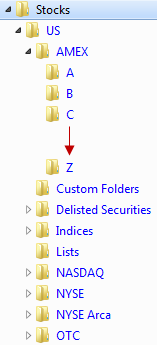LAYOUT & SECURITY TYPES
The US historical database is organised by exchange into sub-folders beneath a US folder. The table below shows the folders and the security types they contain.
A description of each security type can be found towards the bottom of the page.
Folder Layout
The US folder is installed by default to c:\Trading Data\Stocks\US. The illustration below shows the sub-folder layout:

|
Each of the 5 exchange folders has a default A-Z sub-folder structure.
If required, these alphabetical sub-folders can be consolidated by use of the "Database Structure" tool within the Premium Data program.
In addition, Premium Data users can create their own Custom Folders which are based on lists of securities that are stored in text files in the "Lists" folder. |
The "Indices" sub-folder is organised as follows:
Market Breadth Indicators
The following indicators are provided for the Nasdaq, NYSE and
NYSE American exchanges:
- Arms Index (TRIN)
- Advancing Issues with Advancing Volume
- Declining Issues with Declining Volume
- Unchanged Issues with Unchanged Volume
- Advance/Decline Ratio
- Advance/Decline Volume Ratio
- Cumulative Advance Decline Line
- New Highs
- New Lows
- Cumulative New Highs - New Lows Line
The following indicators are provided for the Dow Jones Industrial Average,
Nasdaq 100, S&P 100/500/400/600/1500 and Russell 1000/2000/3000 Indices:
- Advancing/Declining/Unchanged Issues and Volume
- 4/13/26/52 Week New Highs and New Lows
- Cumulative 4/13/26/52 Week New Highs-New Lows Line
- Cumulative Advance-Decline Line
- Advance/Decline Ratio
- % Stocks above their 20/50/100/150/200 day Moving Average
- Arms Index (TRIN)
- Average Bollinger Band %B
- Cumulative Bollinger Band %B
- Average Williams %R
- Cumulative Williams %R (Normalized) Line
- Coppock Indicator
- Intermediate-Term Breadth Momentum Oscillator
- McClellan Oscillator
- McClellan Volume Oscillator
- Swenlin Trading Oscillator
- Zweig Breadth Thrust
Security Types Covered
The service covers exchange-listed securities, as described below. It does not cover Mutual Funds or stock options.
The security type is indicated in the security name by the suffix - e.g. "Common", "PFD", "ETF" etc.
Equities
Common Stock (Common)
The most basic unit of ownership of a public company. Real Estate Investment Trusts ("REITs") are included as "Common".
A REIT is a listed investment company that specialises in real estate investment and management, whether in property, mortgages or a mixture of both.
REITs are not subject to corporate tax, given that they distribute at least 90% of their taxable income to shareholders.
Preferred Stock (PFD)
Non-voting stock that ranks above common stock with respect to dividend allocation and claims to a company's assets in the event of liquidation.
Includes "traditional" preferred, trust preferred, third-party trust preferred, Tangible Equity Units and Preferred Equity Traded Bonds.
Warrants (Warrant)
A warrant is a right to purchase stock at a certain price by a certain date in the future.
Unlike call options issued by options exchanges, corporation-issued warrants that trade on regular exchanges have non-standard terms,
are typically long-dated and result in new stock being created when the right to purchase is exercised.
Rights (Right)
New shares made available to existing shareholders for purchase, the number of shares being in proportion to the
current holding. The new shares are often issued at a discount to the current price.
American Depositary Receipts (ADR)
Certificates issued by US banks that represent shares in foreign companies. ADRs allow US investors to hold and trade shares in foreign companies
as if they were US companies - the ADRs are quoted in, and pay dividends in, US Dollars. The shares themselves are called American Depositary Shares.
Closed-End Fund (CEF)
A type of listed investment company similar to a mutual fund. With a closed-end fund, there a fixed number of shares whose value is determined by
market demand rather than solely by net asset value. The shares trade on exchanges like common stock.
Exchange Traded Debt (DEBT)
Corporate debt securities (Notes, Bonds & Debentures) that are issued in small denominations so as to trade on stock exchanges rather than in the bond market.
Exchange Traded Fund (ETF)
A type of listed investment company similar to a mutual fund. An ETF portfolio mirrors the composition of a particular market index and is designed
to track that index. The shares trade on exchanges like common stock.
Exchange Traded Notes (ETN)
Unsecured debt securities that are issued by investment banks and trade on exchanges like ETFs. Their return is meant to match that of a particular
benchmark, so ETNs are similar to ETFs, except that their value partly depends on the credit-worthiness of the issuer.
Special Investment Product (SIP)
A "pre-packaged" investment vehicle, generally involving the use of derivatives, that offers a particular risk/reward profile with respect to the
performance of an underling equity, basket of equities, commodity, currency or index.
Master Limited Partnership (UNIT)
A "pass through" entity that is not subject to corporate tax as it passes its earnings directly through to unit-holders.
MLPs generally operate businesses that involve natural resources like oil and gas.
Royalty Trust (UNIT)
A "pass through" entity that is organized to receive the earnings from a specific natural resource asset, or group of assets.
|

